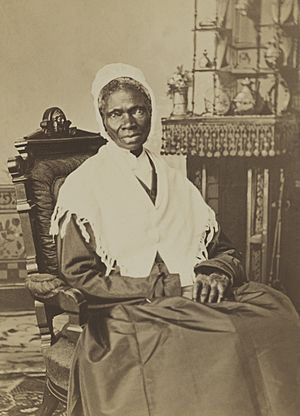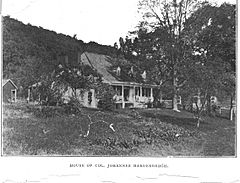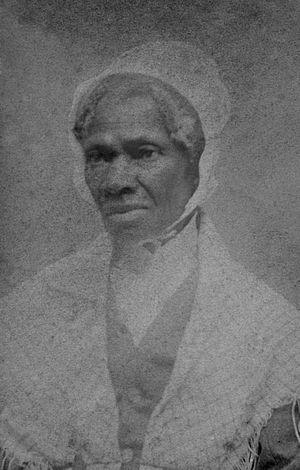Sojourner Truth facts for kids
Quick facts for kids
Sojourner Truth
|
|
|---|---|

c. 1870
|
|
| Born |
Isabella Baumfree
c. 1797 Swartekill, New York, United States
|
| Died | (aged 86) Battle Creek, Michigan, United States
|
| Occupation | Abolitionist, author, human rights activist |
| Parent(s) | James Baumfree Elizabeth Baumfree |
Sojourner Truth (born Isabella Baumfree, around 1797 – November 26, 1883) was an American abolitionist (someone who worked to end slavery) and activist. She also fought for the civil rights of African Americans and the rights of women. She is remembered as a fearless speaker and a tireless fighter for human rights.
Truth was born into slavery in Swartekill, New York, but escaped with her infant daughter to freedom in 1826. After going to court to recover her son in 1828, she became the first black woman to win such a case against a white man.
A memorial bust of Truth was unveiled in 2009 in Emancipation Hall in the U.S. Capitol Visitor Center. She is the first African American woman to have a statue in the Capitol building.
Contents
Early life
Sojourner Truth was born Isabella Baumfree around 1797 in Swartekill, New York. At that time, slavery was legal in many parts of the United States, including New York. Truth was one of the 10 or 12 children born to James and Elizabeth Baumfree (or Bomefree), who were also enslaved.
She was separated from some of her siblings when they were sold to different owners, which was a common and heartbreaking part of slavery. She was sold several times to different owners during her childhood and young adulthood.
In 1799, New York State began passing laws to end slavery, but it was a slow process. Full freedom for enslaved people in New York didn't happen until July 4, 1827. Isabella's owner had promised her freedom earlier, but didn't keep his promise. In late 1826, just before the state's final emancipation date, Isabella bravely escaped to freedom with her infant daughter, Sophia. She later said she didn't "run off" because she thought that was wrong, but she "walked off," believing it was right to seek her freedom.
When she escaped, she had to leave her other children behind because they were not yet legally freed by the state's law. She soon learned that her young son, Peter, had been illegally sold to someone in Alabama. With help from a kind family of Isaac and Maria Van Wagenen in New Paltz, who took her in, Isabella went to court to get her son back. In 1828, she won her case! This was a very significant event, as she became one of the first Black women to win a court case against a white man. This showed her determination and courage in fighting for her family and her rights.
Becoming Sojourner Truth
After gaining her freedom and recovering her son, Isabella lived and worked in New York City. In 1843, she felt called by a spiritual experience to travel and preach. She changed her name to Sojourner Truth. "Sojourner" means a traveler, and "Truth" represented her mission to speak God's truth.
Sojourner Truth began traveling, sharing her experiences and speaking about important issues. She didn't just speak in churches; she spoke at public meetings, conventions, and wherever people would listen. She was known for her powerful voice and her ability to connect with audiences.
As she traveled, Sojourner Truth connected with people involved in different reform movements of the time. She became deeply involved in the movement to abolish slavery and the movement for women's rights. She understood that both groups faced unfair treatment and that their struggles were connected.
Abolitionism
Sojourner Truth was a passionate abolitionist. She spoke out strongly against the cruelty and injustice of slavery. She shared her own story of being enslaved, which helped people understand the harsh reality of the system. She worked alongside other famous abolitionists like Frederick Douglass and William Lloyd Garrison. Women's Rights: Sojourner Truth also believed strongly that women should have the same rights as men. She attended women's rights conventions and gave speeches arguing for equality. The "Ain't I a Woman?" Speech: One of her most famous speeches was given in 1851 at a Women's Rights Convention in Akron, Ohio. In this speech, she spoke about the strength and capabilities of women, particularly Black women who often did hard physical labor. While the exact words of the speech have been recorded differently over time, a popular version includes the powerful question, "Ain't I a Woman?" This question highlighted that Black women were often excluded from the idea of "womanhood" that white women were fighting for, and that they deserved equal rights too. She used her own experiences of hard work and resilience to show that women were just as strong and capable as men.
Civil War efforts
During the American Civil War (1861-1865), which was fought partly over the issue of slavery, Sojourner Truth helped recruit Black soldiers to fight for the Union Army. She believed that helping the Union win would lead to the end of slavery. Her grandson even served in a Black regiment.
After the Civil War ended and slavery was abolished, Sojourner Truth continued her work. She helped formerly enslaved people adjust to freedom. She worked at the Freedman's Hospital in Washington, D.C., helping those who had been enslaved. She also rode on streetcars in Washington to help make sure they were open to everyone, regardless of race. She tried to get the government to provide land to formerly enslaved people, though this effort was not successful during her lifetime.
Fighting for the right to vote
Sojourner Truth was also a strong supporter of women's suffrage, which is the right for women to vote. She argued that women, including Black women, paid taxes and contributed to society, and therefore deserved a voice in government through voting. She even tried to vote herself in 1872 but was turned away.
Later life and death
Sojourner Truth eventually settled in Battle Creek, Michigan, where she continued to speak and advocate for justice. Even as she got older, she kept fighting for important causes, including prison reform and speaking against the death penalty.
Truth was cared for by two of her daughters in the last years of her life. She passed away on November 26, 1883, at her Battle Creek home. On November 28, 1883, her funeral was held and nearly one thousand people attended the service. Truth was buried in the city's Oak Hill Cemetery.
Personal life
Around 1815, Truth met and fell in love with an enslaved man named Robert from a neighboring farm. Robert's owner (Charles Catton, Jr., a landscape painter) forbade their relationship; he did not want the people he enslaved to have children with people he was not enslaving, because he would not own the children.
Truth eventually married an older enslaved man named Thomas. She bore five children: James, her firstborn, who died in childhood, Diana (1815), Peter (1821), Elizabeth (1825), and Sophia (ca. 1826).
In 1839, Truth's son Peter took a job on a whaling ship called the Zone of Nantucket. From 1840 to 1841, she received three letters from him, though in his third letter he told her he had sent five. Peter said he also never received any of her letters. When the ship returned to port in 1842, Peter was not on board and Truth never heard from him again.
Legacy
Sojourner Truth's work had a lasting impact. She is remembered today as one of the most important figures in the fight against slavery and for women's rights in American history. Her courage, powerful words, and dedication continue to inspire people around the world to work for a more just and equal society.
There are many statues, busts, and historical markers in different states like Michigan, Ohio, and New York that remember her life and achievements. In 2009, a bust of Sojourner Truth was placed in the U.S. Capitol building in Washington, D.C., making her the first Black woman to be honored with a statue there.
Schools, libraries, and organizations are named after her to keep her memory and mission alive. For example, a state park in New York near her birthplace is named Sojourner Truth State Park.
She has been recognized on a U.S. postage stamp and included in lists of important Americans. A robotic rover sent to Mars by NASA in 1997 was named "Sojourner" in her honor. The U.S. Treasury announced plans to include her image on the back of a redesigned $10 bill.
Sojourner Truth's life story is a powerful reminder of the importance of fighting for what is right, even when it is difficult. She used her voice and her experiences to challenge unfair systems and demand dignity and equality for all people.
Writings
- Narrative of Sojourner Truth: A Northern Slave (1850).
- Dover Publications 1997 edition: ISBN: 0-486-29899-X
- Penguin Classics 1998 edition: ISBN: 0-14-043678-2. Introduction & notes by Nell Irvin Painter.
- University of Pennsylvania online edition (HTML format, one chapter per page)
- University of Virginia online edition (HTML format, 207 kB, entire book on one page)
Interesting facts about Sojourner Truth
- Her first language was Dutch, as she grew up in an area with many Dutch settlers.
- She changed her name to Sojourner Truth in 1843 because she heard the Spirit of God calling on her to preach the truth.
- Her best-known speech was delivered in 1851, at the Ohio Women's Rights Convention in Akron, Ohio. The speech became widely known during the Civil War by the title "Ain't I a Woman?"
- The first historical marker honoring Truth was established in Battle Creek, Michigan, in 1935.
- Truth is credited with writing a song, "The Valiant Soldiers", for the 1st Michigan Colored Regiment; it was said to be composed during the war and sung by her in Detroit and Washington, D.C. It is sung to the tune of "John Brown's Body" or "The Battle Hymn of the Republic".
- In 2014, Truth was included in Smithsonian magazine's list of the "100 Most Significant Americans of All Time."
See also
 In Spanish: Sojourner Truth para niños
In Spanish: Sojourner Truth para niños



